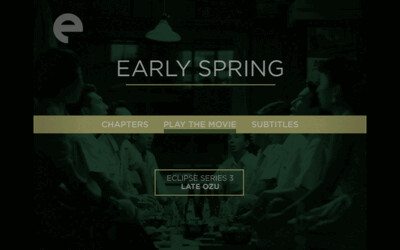
Yasujiro Ozu is one of the old masters of Japanese cinema. He began making films in 1927, during the silent era, and carried on doing so until 1962. As with any artist, he survived the undulating tide of fashion, falling out of critical favor when a new wave of Japanese directors decided to change the scene. On paper, that itself is almost like a plot out of one of Ozu's own films, which often dealt with the schism between the young and the old, youth's boastful self-possession clashing with knowledge and experience. Time would eventually bear Ozu out, and his oeuvre is now acknowledged for its breadth and consistency.
Naturally, with a filmmaker who has made as many motion pictures as Ozu has, sprucing all of them up for the DVD age would take a Herculean effort. The Criterion Collection established their Eclipse Series offshoot to handle just such a problem, creating lower-priced, no-frills boxed sets to handle pieces of a director's filmography that might otherwise languish on a shelf for years while studios worked their way through the more in-demand touchstones of an auteur's work. The Eclipse sets have so far been arranged by two thematic approaches: a particular type of film from a director's catalogue (such as the non-fiction selections in Series 2, The Documentaries of Louis Malle) or a specific timeframe in the director's career (five of the first films Ingmar Bergman made were bundled as Series 1, Early Bergman). Series 3 falls in the latter category. Late Ozu brings together five movies from the last seven years of Ozu's career. Made between 1956 and 1961, the only films not represented from this period are either already available through Criterion (Good Morning, Floating Weeds) or still awaiting a DVD release (his last movie, An Autumn Afternoon).
Unlike the Early Bergman box, where the set showed a style in development, Late Ozu showcases a journeyman whose themes and style have been carved out and are at the point where they are just being polished. Ozu's reputation was earned on dramas that dealt with issues of ordinary people, usually focusing on some element of family. Though his stories were generally sentimental, he kept them from being maudlin or mawkish through sweetness and humor. The director was also a master of unhurried pacing. He employed long, steady shots to let the emotion of a scene have time to take root, and he never rushed a moment. He understood that inaction was sometimes the best action. An appropriately placed pregnant pause could do more damage than a punch in the nose. Similarly, just by choosing the proper season for a particular story section to take place in, Ozu could create a setting more evocative than any done with computers and digital painting. The outer weather and climate equaled interior mood.
All of these hallmarks of the Ozu style remain intact in Late Ozu, but even within such a well-defined technique, he still had room to roam and explore. He may have been an old dog by 1956, but he wasn't out of tricks.
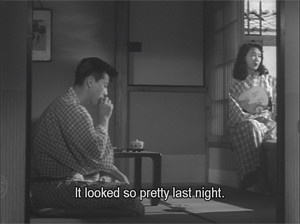
* Early Spring (Soshun) (black-and-white; 145 minutes - 1956): For the subject of Early Spring, Ozu chose the young commuters who traveled into Tokyo every day on crowded trains to work in drab, stifling offices doing uninteresting jobs. Most of the men are young enough to have served in WWII, but not so old that they can't make a transition into something else. It seems to me the title likely is meant to invoke a time where the onset of change is still early, but also, ironically, a time when things get planted and their course of growth is set.
Ozu chooses to start the film in a rather interesting way. He trains his camera on the human stew, going from house to house as workers wake up and head for work. He stirs the pot so that all the various members of the large cast drift by before his main characters rise to the surface. The focal point of Early Spring is Shoji (Ryo Ikebe), a veteran in his early thirties who has become a white-shirted salaryman. The various philosophical anxieties of modern life are coming to a head for poor Shoji. One of his best friends is sick and possibly dying, and his reunions with his old army unit just remind him of past glories. His marriage to Masako (Chikage Awashima) has grown stale, and as we learn more about them, we also learn that there is a deeper, more profound rift between them, an estrangement built on loss. Shoji wants to go out drinking and playing mahjong in the evenings, and on nature hikes with his coworkers on the weekend; Masako wants to stay home. Thus, he gets involved with a colleague nicknamed Goldfish (Keiko Kishi), a needy woman who is a bit of an office joke. As the gossip about the new couple begins to grow, so too does the chasm between husband and wife.
Early Spring was Ozu's forty-sixth film in twenty-eight years, and it followed on the heels of his most lasting success, Tokyo Story. All of the familiar themes of community and family are still there, especially as Shoji's friends gather for a love intervention and Masako's provide her with a place to retreat to as her husband's indiscretions come to light. Yet, the normally good-natured director can't provide any clear advice for his hero. Shoji's elders offer no hope. Their own dimming lives only speak to the diminishing returns of Shoji's career, and they would all rather see him jump the course, even if they don't always say it outright. Shoji's crisis is over which of all of these elements he chooses.
There are no histrionics on display in the interpersonal dramas. Most things are discussed quietly, often sitting down. Only Goldfish gets any real outburst, which is probably her due since her passionate love affair with Shoji is just as restrained as their do-nothing jobs. Some of Shoji's soldier buddies imbibe in spirits, but it only proves to make them talkative and pathetic. The most anyone can muster is an ironic singalong of "Auld Lang Syne." Even so, the sadness builds to a bittersweet conclusion that signals hope, but that almost feels like doom in disguise.

* Tokyo Twilight (Tokyo boshoku) (black-and-white; 141 min. - 1957): Similar themes of parents being unable to steer their wayward children in the proper direction give shape to Tokyo Twilight. It's a sign of the shifting times that Ozu, who usually ended up siding with the elder faction in the generational divide, made this duo of movies where the older folks no longer had any wisdom to impart that would set youth on the straight and narrow. The sins of the past were being visited on the present.
Plot-wise, Tokyo Twilight is a bit like an East of Eden
There is a startlingly dark gravity to Tokyo Twilight that one wouldn't normally expect from an Ozu film. He tackles quite a few heavy subjects here, and Tokyo Twilight is actually quite progressive in its honest portrayal of society's normally unspoken secrets. There is a literal crossing of the tracks in the movie when Akiko goes from her safe Tokyo home to a less savory district where her boyfriend likes to gamble. Guarding this entryway, which we are told is actually nicknamed Devil's Crossing, is a billboard with a pair of glasses, presumably warning her to watch out for the ways of sin. It reminds me of Fitzgerald's similar billboard for Dr. T.J. Eckleburg in The Great Gatsby

* Equinox Flower (Higanbana) (color; 118 min. - 1958): Father and daughter relations are also the central conflict of Ozu's Equinox Flower, made a year after Tokyo Twilight. In this, his first color film, the director would give himself over once and for all to changing times. Equinox Flower stars Shin Saburi as Hirayama, a graying father of two who is full of conflict. Feeling that his own marriage was lacking because it had been arranged for him, he supports the new generation's desire to change tradition and choose their spouses out of love. That is, he supports these ideas as they apply to other people's daughters, not his own. Though his oldest child, Setsuko (Ineko Arima), has picked a man for herself, Hirayama stands against her, insisting that she does not know if her fiancé is truly a good man.
Yet, he contradicts his own harsh position when it comes to advising other young women. When an old school buddy (Chishu Ryu again) comes to him for help, Hirayama builds a bridge between the man and his estranged daughter, who now works as a cocktail hostess and lives out of wedlock with her musician boyfriend. Likewise, when Yukiko (Fujiko Yamamoto), the daughter of a family friend, ponders how she can escape the bad matches her mother keeps trying to make for her, Hirayama instructs her to follow her own heart. He never sees the division in his thinking, not even when it's pointed out to him. Part of his problem is that he's not ready to see his daughter leave the nest, but it's also that change is hard, and for as much as he wants to be progressive, he's not ready to give up control to the generation on its way up. At regular class reunions, he and the other old patriarchs that he went to school with all express bafflement at the way social standards have shifted. Through the gentle urging of his wife (Kinuyo Tanaka), as well as the example of the other girls he's been asked to counsel, Hirayama will eventually have to learn to cope.
Ozu takes it easy on his protagonist. Though the character's hypocrisy is plainly evident, Ozu isn't one to make him look foolish; rather, he shows Hirayama as an essentially good man, so much so that other fathers turn to him for advice. The director never puts too fine a point on it, but it's a contradiction as old as time: we can always see our own inherent flaws in others even as we are blind to them in ourselves. Ozu uses the frame of the camera lens to cradle his old man into a new way of thinking. There are no sweeping movements, no complicated compositions, but simple, straight-on shots. He doesn't jar or jostle, but eases the story along, refraining from having anyone even raise his or her voices. Rather, Ozu lets the women massage Hirayama's opinions in the right direction, their quiet rebellion being more powerful than any blunt force--or for that matter, overly dramatic film technique--could ever hope to be.
Ozu also uses a soft touch with color for his first time out, not overdoing it with an explosion of brightness but instead only using more vibrant hues when it fits the story. As visual metaphors, things like hot-colored clothes and bright orange soda bottles stand out as symbols of the younger generation, while Hirayama and his chums wear their drab suits. Even their hair is losing its luster, the black pigment disappearing, giving way to gray and eventually white. It's an impressively aggressive adaptation on the part of the director, taking advantage of his new tools in his trademark style of intelligent restraint.
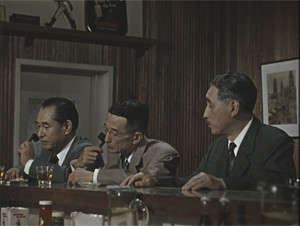
* Late Autumn (Akibiyori) (color; 129 min. - 1960): By contrast, Late Autumn has a richer, less conspicuous color scheme, but it is also more rigidly formal. A reinterpretation of the 1949 Ozu film Late Spring, this story of three men searching for husbands for their late colleague's daughter and widow is composed entirely of straight-ahead set-ups, using the square 1.33:1 aspect ratio like a picture frame, locking the drama down inside. In conversations, Ozu mechanically cuts back and forth from one speaker to the other, calling attention to his style by his willful lack of it.
The effect of this choice is a nod to tradition. Not only is Ozu reliving a former success, but he also seems to be reclaiming the most obvious signatures of his technique. Yet, this choice also skews ironic. The director is having a bit of fun with his male leads, an out-of-date trio who think they know how the world works but are really bumbling through it (they are played by Ryuji Kita, Nobuo Nakamura, and a returning Shin Saburi). Their matchmaking skills leave something to be desired, particularly as two of them have a crush on the mother (Setsuko Hara) and are really only reaching out in order to indulge their egos. Though Late Autumn is primarily the mellowest of melodramas, Ozu sneaks in some good chuckles here and there, usually at the expense of these three aging lotharios. The movie particularly comes to life when the guys are taken to task by a young friend of the girl they are supposed to be helping. Yuriko, played by the adorable Mariko Okada, not only sets these dummies straight, but she gets them to pay for a night of sake and sushi, too. Note how Ozu lets Okada engage with the camera more than anyone else in the film. She alone is the spirit of youth. Yuriko is the most animated character in the movie, sticking her tongue out, spinning to look over her shoulder as she walks away, and speaking her mind freely. It's a crush-worthy performance.
The true heart of Late Autumn, however, is the mother/daughter relationship. Ayako (Yoko Tsukasa) is avoiding marriage because she doesn't want to leave her mother alone. Likewise, the elder woman, Akiko, is willing to sacrifice her own desires in order to see her daughter achieve happiness. There are shades of O. Henry in how neither knows the lengths the other is willing to go to on her behalf. Their devotion lends a wholesomeness to the movie that Ozu makes work without becoming encumbered by sentimentality the way less sincere directors would. It's why, despite its creeping pace, Late Autumn maintains a warmth that is pleasing up to the very end.
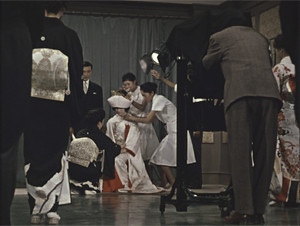
* The End of Summer (Kohayagawake no aki) (color; 103 min. - 1961): Both Setsuko Hara and Yoko Tsukasa return in The End of Summer, this time playing sisters instead of mother and daughter, but still portraying women in search of husbands. Hara's Akiko is even a widow, while Tsukasa's Noriko is torn between the man her family has found for her and the man she met at her office job. The office set looks very similar to the one Ayako worked at in Late Autumn, and these shared studios and cast members provide a continuity to all of these Ozu movies, as if they were part of an ongoing serial rather than separate entities. These female characters could be the same in both movies, just as the wedding ceremony at the end of Late Autumn could be the same as the one at the beginning of Equinox Flower. As a crash course in the director, Late Ozu speaks loudly to the consistency of his work.
Of all the movies in the box, The End of Summer is the most adept at capturing both the laughter and the tears of family life. The Kohayagawa family runs an ailing sake brewery. They struggle along on their own while larger companies swallow up others of their kind. The head of the family, Manbei (Ganjiro Nakamura), has reached the stage of life where he returns to childish things, sneaking out of the house to see his mistress and gleefully lying to cover his tracks. Though he causes his family no end of frustration, he will end up being the example by which his daughters learn to pursue their own happiness rather than doing what is expected of them. Even as the men of the family feel crushed by the demands of the business, Akiko and Noriko find freedom in jettisoning from their daughterly duties. The pair practically operates as a separate pocket, anyway, stealing away to discuss their romantic desires in secret rather than talking openly with their siblings.
The End of Summer was Ozu's second-to-last film, and it's a fitting lid to put on the Late Ozu - Eclipse Series boxed set. While the title here obviously refers to the twilight years of Manbei, it's also the signal for his daughters to finally make a decision about their lives. Traditionally, when summer ends, work and school reconvenes. So, too, must life go on.
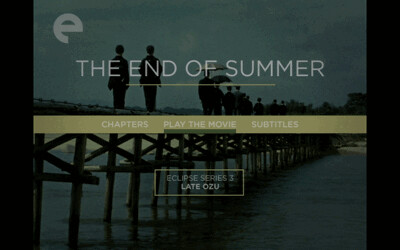
With Late Ozu, Criterion's boutique Eclipse Series continues its winning streak. Picking five thematically linked movies from the last years of Yasujiro Ozu's career, they have created a primer of the great Japanese director's work. These dramas about the bonds of family and the struggle between the generations as traditions pass away and social expectations change are all captivating, thoughtful creations. In a parallel line to the narrative themes, we see a change in style and skill as the veteran filmmaker also transitions from black-and-white to color. While some my gripe at the unadorned presentations, Late Ozu fulfills the Eclipse manifesto of creating a mini retrospective of films that might otherwise languish in the vaults waiting for a bigger release.
Originally written June 12, 2007. For technical specs and special features, read the full article at DVD Talk.

2 comments:
I was glad to find your review of the Late Ozu collection. I thought I would point out in passing that the English title of the last film in the series differs from the original in a significant way. In a sense, the English title End of Summer seems to fit the tradition of Ozu titles more than the original one: The Autumn of the Kohayagawa Family. (Only in one other film does he use a specific family name). This might affect your interpretation of the meaning of the title in the last paragraph of your review.
Post a Comment